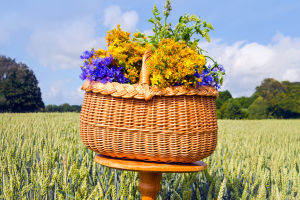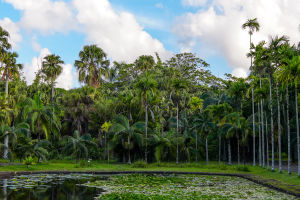Climate change is one of the most pressing issues of our time. While it is often discussed in terms of its impacts on human life and the environment, its effects on plants are just as significant.
Plants are the foundation of ecosystems, providing oxygen, food, and habitat for many species. As global temperatures rise, weather patterns shift, and the atmosphere changes, plants are facing threats that could alter the course of life on Earth.
In this article, we'll explore how climate change is jeopardizing plant survival and disrupting the ecological balance.
Changing Weather Patterns: A Challenge for Plants
Plants are highly sensitive to changes in temperature, rainfall, and other weather patterns. As the planet warms, many regions are experiencing more extreme weather events—longer droughts, unpredictable rainfalls, intense storms, and even floods. These changes make it difficult for plants to thrive in their traditional environments.
For instance, droughts are becoming more frequent and severe in many parts of the world. This reduces the availability of water for plants, especially those in arid or semi-arid areas. Plants that rely on consistent rainfall patterns for survival may not be able to withstand the increased unpredictability. Similarly, excessive rainfall or flooding can damage plants' root systems, suffocating them and preventing proper growth.
Temperature Changes: A Life-or-Death Factor
Temperature is a key factor in plant growth. Most plants have an optimal temperature range for photosynthesis, growth, and reproduction. Climate change is causing average temperatures to rise, which is pushing many plants outside of their preferred temperature zones.
This shift can have severe consequences. For example, crops such as wheat, corn, and rice are highly sensitive to temperature changes. Warmer temperatures can decrease crop yields, while frost at the wrong time can destroy crops altogether. Additionally, plants that are adapted to cooler climates, like those in the Arctic, are facing extinction as their habitats become warmer. In some cases, plants may attempt to migrate to higher altitudes or latitudes to find suitable conditions, but this can be a slow process, and many plants may not survive the journey.
Disrupted Seasons: Impact on Growth Cycles
Climate change is also affecting the seasons, altering the timing of key biological events such as flowering, fruiting, and leaf shedding. Plants depend on seasonal cues to regulate their growth and reproduction. However, with warming temperatures, these cues are becoming less predictable.
For example, some plants may bloom earlier in the year due to warmer temperatures, only to find that the necessary pollinators, like bees, are not yet active. This mismatch in timing can result in poor pollination and reduced plant reproduction. Similarly, plants that rely on specific temperature thresholds for seed germination may find that those conditions no longer occur, reducing their ability to regenerate.
Rising CO2 Levels: A Double-Edged Sword
Rising levels of carbon dioxide (CO2) in the atmosphere, a direct result of human activities like burning fossil fuels, can have a complex effect on plants. On the one hand, CO2 is a crucial component of photosynthesis, and higher CO2 levels can stimulate plant growth. However, this growth is not always beneficial.
In many cases, increased CO2 is leading to a phenomenon known as "CO2 fertilization," where plants grow larger but with lower nutritional content. For crops, this means that while the plant may grow bigger, it may not provide as much nutritional value. This could have long-term implications for food security, especially for populations dependent on staple crops like wheat, rice, and maize.
Invasive Species: The New Threat
As climate change shifts ecosystems, invasive species are becoming a larger threat to native plants. Warmer temperatures and altered weather patterns provide favorable conditions for non-native species to thrive in new areas. These invasive species often outcompete native plants for resources like water, sunlight, and nutrients, leading to a decline in biodiversity.
For example, certain plant species that were previously restricted to tropical climates are now expanding into temperate regions. These species can disrupt local ecosystems and make it harder for native plants to survive. The spread of invasive plants is also linked to changes in animal behavior, as herbivores may start feeding on plants they have not previously eaten.
What Can We Do? The Road Ahead
The threat to plant survival from climate change is real, but there are actions we can take to help mitigate the damage. First, we must address the root cause—carbon emissions. Reducing greenhouse gas emissions and transitioning to renewable energy sources can slow the pace of climate change and provide plants with a fighting chance.
We also need to focus on conservation efforts. Protecting existing ecosystems and promoting biodiversity can help plants better adapt to changing conditions. By supporting sustainable farming practices, restoring habitats, and protecting endangered species, we can ensure that plant life continues to thrive.
Additionally, scientists are exploring ways to breed plants that are more resilient to climate change. Through genetic research, we may be able to develop crops and plants that can withstand extreme temperatures, droughts, and other challenges posed by a changing climate.
Conclusion: A Call to Action
As we've seen, climate change is a significant threat to plant survival and the delicate balance of our ecosystems. Plants are essential to our survival, providing oxygen, food, and shelter, and supporting the entire food chain. The disruptions caused by climate change are putting this vital resource at risk.
But there is hope. By taking action to reduce emissions, conserve ecosystems, and support resilient agricultural practices, we can help protect plants and ensure the health of our planet for future generations. Now, more than ever, it is essential that we understand the link between climate change and plant life, and work together to preserve the green heart of the Earth.
What steps do you think we can take to protect plants from the effects of climate change? Share your thoughts in the comments below!


